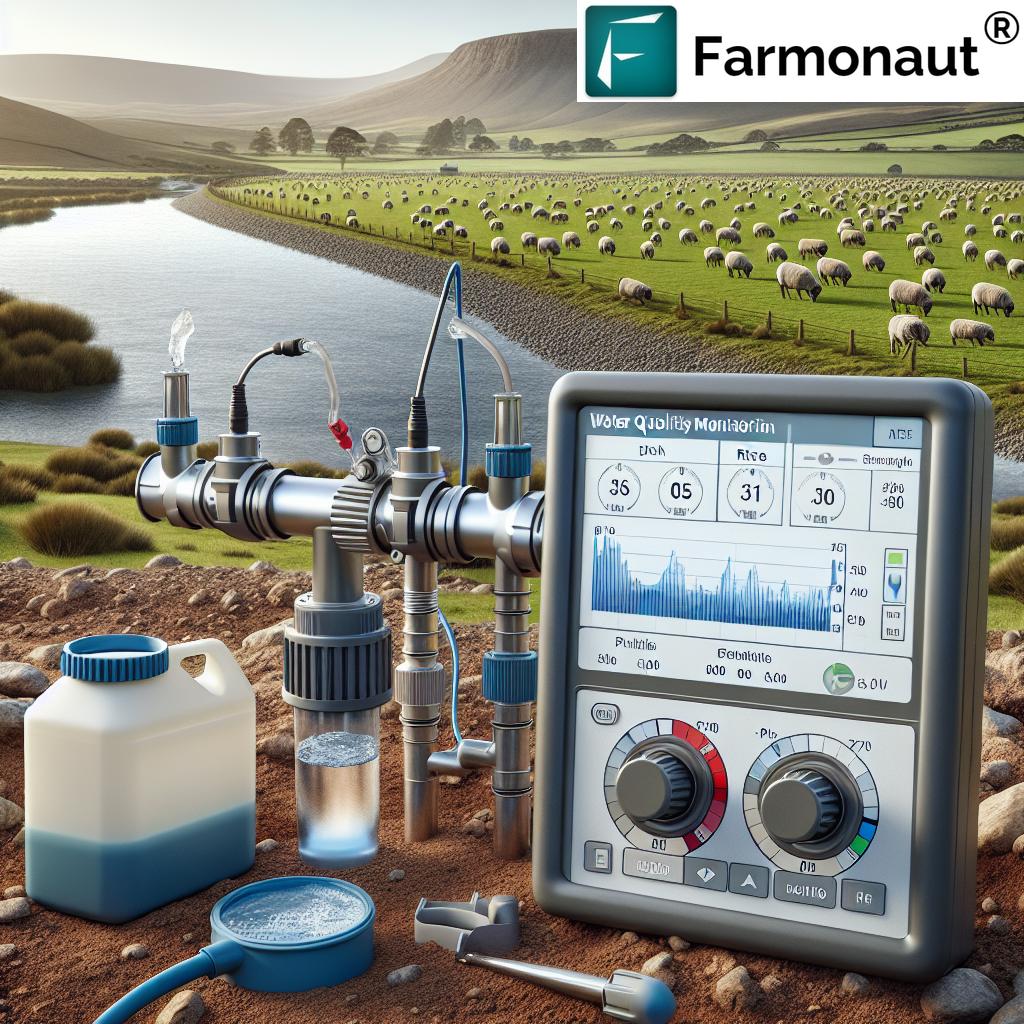Mastering Livestock Water Quality: A Comprehensive Guide for Sheep Farmers in Wudinna
“Regular EC testing can detect salinity issues in livestock water, with ideal levels below 5,000 μS/cm for sheep.”

Welcome to our comprehensive guide on mastering livestock water quality for sheep farmers in Wudinna. As we delve into the intricacies of water quality testing for livestock and sheep farming water management, we’ll explore practical methods and cutting-edge technologies that can revolutionize your farming practices. At Farmonaut, we understand the critical role that water plays in the health and productivity of your flock, and we’re here to help you navigate the complexities of water management with precision and ease.
The Importance of Water Quality in Sheep Farming
In the vast pastoral regions of Wudinna, water is more than just a resource – it’s the lifeblood of your sheep farming operation. The quality of water your livestock consumes directly impacts their health, wool production, and overall farm productivity. As stewards of the land and our flocks, it’s our responsibility to ensure that the water we provide is not just abundant, but of the highest quality possible.
Let’s break down why water quality is so crucial:
- Health and Productivity: Clean, safe water is essential for maintaining the health of your ewes, rams, and lambs. It affects digestion, nutrient absorption, and overall bodily functions.
- Wool Quality: High-quality water contributes to better wool production, ensuring that your sheep produce the finest fleece possible.
- Disease Prevention: Proper water management helps prevent waterborne diseases and reduces the risk of parasites like worms.
- Environmental Sustainability: Efficient water use and management contribute to the sustainable use of our precious water resources in Wudinna’s often drought-prone climate.
Now that we’ve established the importance of water quality, let’s dive into the practical aspects of water testing and management.
Understanding Electrical Conductivity (EC) in Agriculture
Electrical conductivity in agriculture is a key measure of water quality, particularly relevant to livestock water monitoring. EC measures the ability of water to conduct an electrical current, which directly correlates to the amount of dissolved salts in the water. For sheep farmers in Wudinna, understanding and regularly testing EC levels is crucial for several reasons:
- It indicates the salinity levels in water, which can affect sheep health and water palatability.
- High EC levels can lead to reduced water intake, affecting hydration and overall health of your flock.
- It helps in identifying potential issues with water sources, such as contamination or changes in underground water quality.
To effectively measure EC, we recommend using reliable EC meters. These devices are essential tools in your water quality testing arsenal. Here’s how to use an EC meter effectively:
- Calibrate your EC meter according to the manufacturer’s instructions before each use.
- Collect a water sample from your stock bore or trough in a clean container.
- Immerse the EC meter probe into the water sample, ensuring it’s fully submerged.
- Wait for the reading to stabilize and record the measurement.
- Rinse the probe with distilled water between samples to prevent cross-contamination.
Remember, the ideal EC range for sheep water is typically below 5,000 μS/cm. Regular testing and monitoring of EC levels will help you maintain optimal water quality for your flock.
Implementing Sustainable Water Practices in Farming
Sustainable water practices are at the heart of efficient sheep farming in Wudinna. By implementing these practices, we not only ensure the health of our livestock but also contribute to the long-term sustainability of our farming systems. Here are some key strategies to consider:
- Regular Testing of Stock Bores and Troughs: Implement a routine testing schedule for all water sources on your property. This includes both stock bores and troughs.
- Water Conservation Techniques: Utilize water-saving technologies such as float valves in troughs to prevent overflow and waste.
- Rainwater Harvesting: Consider implementing rainwater collection systems to supplement your water supply, especially during dry periods.
- Pasture Management: Practice rotational grazing to prevent overgrazing near water sources, which can lead to soil erosion and water contamination.
- Water Recycling: Explore options for recycling and treating wastewater for non-potable uses on the farm.
By adopting these sustainable practices, we can ensure a steady supply of high-quality water for our sheep while also preserving this precious resource for future generations.
The Importance of pH Testing in Livestock Water
“pH testing is crucial for sheep water, with optimal levels ranging between 6.5 to 8.5 for livestock health.”
pH testing is another critical aspect of livestock water monitoring. The pH level of water can significantly impact sheep health and their willingness to drink. Here’s why pH matters:
- Optimal pH levels ensure proper digestion and nutrient absorption in sheep.
- Extreme pH levels can affect the taste of water, potentially leading to reduced water intake.
- pH levels outside the optimal range can interact with medications or supplements added to the water.
To conduct pH testing, follow these steps:
- Use a calibrated pH meter or pH test strips for accuracy.
- Collect a fresh water sample from your water source.
- If using a pH meter, immerse the probe and wait for a stable reading.
- For test strips, dip the strip into the water and compare the color to the provided chart.
- Record the pH level and date for your records.
Aim to maintain pH levels between 6.5 and 8.5 for optimal sheep health. Regular pH testing should be part of your routine water quality management plan.
Agricultural Water Quality Standards for Sheep Farming
Understanding and adhering to agricultural water quality standards is crucial for sheep farmers in Wudinna. These standards ensure that the water we provide to our livestock meets the necessary quality requirements for their health and productivity. Let’s explore the key parameters and their recommended levels:
| Parameter | Optimal Range | Testing Method | Testing Frequency | Potential Health Impact on Sheep |
|---|---|---|---|---|
| pH | 6.5 – 8.5 | pH meter or test strips | Monthly | Affects digestion and nutrient absorption |
| Electrical Conductivity (EC) | < 5,000 μS/cm | EC meter | Monthly | Indicates salinity; high levels can cause dehydration |
| Total Dissolved Solids (TDS) | < 3,000 mg/L | TDS meter | Quarterly | Affects water palatability and mineral intake |
| Nitrates | < 100 mg/L | Test kit or lab analysis | Bi-annually | High levels can cause methemoglobinemia |
| Sulfates | < 1,000 mg/L | Lab analysis | Annually | Excessive levels can cause diarrhea |
By regularly monitoring these parameters and ensuring they fall within the recommended ranges, we can safeguard the health of our sheep and optimize their performance.
Precision Agriculture Water Management Techniques
Precision agriculture water management is revolutionizing the way we approach water usage in sheep farming. By leveraging technology and data-driven insights, we can optimize water distribution, reduce waste, and improve overall farm efficiency. Here are some cutting-edge techniques that can be applied in Wudinna:
- Satellite-Based Monitoring: Utilize satellite imagery to assess pasture health and soil moisture levels, helping inform water management decisions.
- Smart Water Meters: Install IoT-enabled water meters to track water usage in real-time and detect leaks or abnormalities quickly.
- Weather Forecasting Integration: Incorporate accurate weather forecasts into your water management strategy to anticipate rainfall and adjust irrigation schedules accordingly.
- Soil Moisture Sensors: Deploy soil moisture sensors across your property to optimize watering schedules and prevent over-irrigation.
- Automated Irrigation Systems: Implement automated systems that can adjust water flow based on real-time data from sensors and weather forecasts.
At Farmonaut, we offer advanced satellite-based solutions that can significantly enhance your water management practices. Our platform provides real-time insights into vegetation health, soil moisture levels, and other critical metrics, enabling you to make informed decisions about water usage and distribution.
By integrating these precision agriculture techniques into your farming operations, you can achieve more efficient water use, reduce costs, and improve the overall sustainability of your sheep farm in Wudinna.
The Connection Between Water Quality and Livestock Health
The relationship between water quality and livestock health is intricate and profound. For sheep farmers in Wudinna, understanding this connection is crucial for maintaining a healthy and productive flock. Let’s explore how various aspects of water quality directly impact sheep health:
- Hydration and Metabolism: Clean, palatable water encourages adequate hydration, which is essential for proper digestion, nutrient absorption, and overall metabolic function in sheep.
- Disease Prevention: High-quality water reduces the risk of waterborne diseases and parasitic infections, such as worms and flies, which can be detrimental to sheep health.
- Reproductive Health: Proper hydration and mineral balance, maintained through good water quality, are crucial for the reproductive success of ewes and rams.
- Wool Production: The quality and quantity of wool produced by sheep are directly influenced by their overall health, which is significantly impacted by water quality.
- Growth and Development: Lambs and weaners require clean, safe water for optimal growth and development, affecting their long-term productivity.
To ensure the best possible health outcomes for your flock, consider implementing the following practices:
- Regular vaccination programs to prevent water-related diseases.
- Monitoring for signs of water-related health issues, such as diarrhea or reduced wool quality.
- Implementing proper drainage around water sources to prevent the breeding of pests like flies.
- Ensuring easy access to clean water, especially for lambs and pregnant ewes.
- Regularly cleaning and maintaining water troughs to prevent algae growth and contamination.
By prioritizing water quality, we not only safeguard the health of our sheep but also enhance the overall productivity and sustainability of our farming operations in Wudinna.
Integrating Water Quality Management into Farming Systems
Integrating water quality management into your overall farming systems is essential for long-term success in sheep farming. This holistic approach ensures that water quality considerations are woven into every aspect of your farm operations. Here’s how you can achieve this integration:
- Develop a Water Management Plan: Create a comprehensive plan that outlines testing schedules, maintenance routines, and response protocols for water quality issues.
- Train Farm Staff: Ensure all farm workers are trained in water quality testing procedures and understand the importance of maintaining high water standards.
- Incorporate Technology: Utilize farm management software to track water quality data, set reminders for testing, and analyze trends over time.
- Align with Grazing Strategies: Coordinate your water management efforts with your grazing plans to ensure optimal distribution of water resources across pastures.
- Regular Infrastructure Assessment: Conduct routine inspections of water infrastructure, including bores, pumps, and troughs, to prevent contamination and ensure efficient distribution.
By integrating these practices, you create a robust system that not only maintains high water quality but also enhances overall farm efficiency and livestock health.
Leveraging Technology for Water Quality Monitoring
In today’s digital age, technology plays a crucial role in enhancing our ability to monitor and manage water quality effectively. For sheep farmers in Wudinna, leveraging these technological advancements can lead to more precise, efficient, and sustainable water management practices. Here are some innovative tools and techniques to consider:
- Remote Sensing: Utilize satellite imagery and drone technology to assess large areas of your property for water-related issues, such as leaks or areas of poor drainage.
- IoT Sensors: Deploy Internet of Things (IoT) sensors in water sources to continuously monitor parameters like pH, EC, and temperature in real-time.
- Data Analytics: Use data analysis tools to interpret water quality trends over time, helping you make informed decisions about water management strategies.
- Mobile Apps: Leverage smartphone applications for on-the-go water quality testing and record-keeping, ensuring you always have access to crucial data.
- Automated Alert Systems: Implement systems that send notifications when water quality parameters fall outside of acceptable ranges, allowing for quick response to potential issues.
At Farmonaut, we understand the importance of technology in modern farming. Our platform integrates advanced satellite technology with AI-driven insights to provide you with comprehensive data on your farm’s water resources. This technology can help you:
- Monitor soil moisture levels across your property
- Detect potential water stress in pastures
- Optimize irrigation schedules based on real-time data
- Track changes in water bodies and catchment areas over time
By integrating these technological solutions into your water quality management strategy, you can achieve a new level of precision and efficiency in your sheep farming operations.
Best Practices for Water Testing in Sheep Farms
Implementing a robust water testing regime is crucial for maintaining optimal water quality for your sheep. Here are some best practices to ensure accurate and effective water testing on your farm in Wudinna:
- Establish a Regular Testing Schedule: Set up a consistent schedule for water testing, with more frequent tests during high-risk periods such as drought or after heavy rains.
- Use Clean Testing Equipment: Ensure all testing equipment, including sample containers and probes, are clean and properly calibrated before each use.
- Sample from Multiple Points: Collect water samples from various points in your water system, including sources (bores, dams) and endpoints (troughs).
- Follow Proper Sampling Techniques: When collecting samples, allow the water to run for a few minutes before collection to ensure a representative sample.
- Record Keeping: Maintain detailed records of all test results, including date, time, location, and any observations.
- Professional Analysis: While on-farm testing is valuable, periodically send samples to a certified laboratory for comprehensive analysis.
- Interpret Results Carefully: Learn to interpret test results and understand what they mean for your sheep’s health and farm management.
- Act on Results: Develop action plans for addressing any water quality issues identified through testing.
- Stay Informed: Keep up-to-date with the latest water quality standards and testing methods relevant to sheep farming in Wudinna.
By following these best practices, you can ensure that your water testing efforts are effective and provide valuable insights for maintaining high-quality water for your sheep.

Addressing Common Water Quality Challenges in Wudinna
Sheep farmers in Wudinna face unique water quality challenges due to the region’s specific environmental conditions. Understanding and addressing these challenges is crucial for maintaining healthy livestock and sustainable farming practices. Let’s explore some common issues and their solutions:
- High Salinity:
- Challenge: Wudinna’s groundwater can have high salt content, affecting water palatability and sheep health.
- Solution: Implement desalination systems or blend high-salinity water with fresher sources. Regular EC testing is crucial.
- Algal Blooms:
- Challenge: Warm temperatures and nutrient-rich water can lead to algal blooms in dams and troughs.
- Solution: Use aeration systems, shade covers for water sources, and regularly clean troughs. Consider algaecides when necessary.
- Mineral Imbalances:
- Challenge: Local water sources may have imbalances in minerals like iron or calcium.
- Solution: Conduct comprehensive mineral analysis and implement appropriate filtration or treatment systems.
- Drought-Related Issues:
- Challenge: Prolonged dry periods can concentrate contaminants in water sources.
- Solution: Develop drought management plans, including alternative water sources and increased testing frequency during dry spells.
- Contamination from Agricultural Runoff:
- Challenge: Pesticides or fertilizers from nearby crop farms can contaminate water sources.
- Solution: Establish buffer zones around water sources and collaborate with neighboring farmers on responsible chemical use.
By proactively addressing these challenges, sheep farmers in Wudinna can ensure a consistent supply of high-quality water for their flocks, even in the face of environmental challenges.
The Role of Technology in Water Quality Management
Technology plays a pivotal role in modern water quality management for sheep farms. At Farmonaut, we’re at the forefront of integrating cutting-edge technology into agricultural practices. Here’s how technology can revolutionize your water quality management:
- Satellite-Based Monitoring: Our satellite technology provides comprehensive views of your farm, helping you identify potential water issues before they become problematic.
- AI-Powered Analytics: Advanced algorithms analyze data from various sources to provide actionable insights on water quality and usage patterns.
- Remote Sensing: Detect changes in water bodies, soil moisture, and vegetation health, which can indicate water quality issues.
- Mobile Applications: Access real-time data and manage your water resources on-the-go with our user-friendly mobile apps.
- Integration with Weather Data: Combine water quality information with accurate weather forecasts to make informed decisions about water management.
By leveraging these technological solutions, sheep farmers in Wudinna can achieve unprecedented levels of precision and efficiency in their water quality management efforts.
Sustainable Water Management for Long-Term Farm Success
Sustainable water management is not just an environmental consideration; it’s a critical factor in the long-term success and viability of sheep farms in Wudinna. By adopting sustainable practices, we can ensure the continued availability of high-quality water for our livestock while also preserving this precious resource for future generations. Here are key strategies for implementing sustainable water management:
- Water Conservation: Implement water-saving technologies and practices to reduce overall water usage without compromising sheep health.
- Catchment Management: Develop and maintain efficient catchment systems to maximize the use of rainwater and reduce reliance on groundwater.
- Soil Health Improvement: Enhance soil structure and organic matter content to improve water retention and reduce runoff.
- Native Vegetation Preservation: Maintain or restore native vegetation around water sources to act as natural filters and prevent erosion.
- Efficient Irrigation Systems: If irrigation is used, opt for high-efficiency systems that minimize water waste.
- Water Recycling: Explore opportunities for safely recycling and reusing water on the farm.
- Education and Training: Regularly update your knowledge and skills in water management, and ensure your farm staff are well-trained in sustainable practices.
By implementing these sustainable water management practices, we not only secure the future of our farms but also contribute to the broader environmental health of the Wudinna region.
Conclusion: Empowering Sheep Farmers in Wudinna
As we conclude this comprehensive guide on mastering livestock water quality for sheep farmers in Wudinna, it’s clear that effective water management is a multifaceted endeavor that requires dedication, knowledge, and the right tools. By understanding the importance of water quality testing, implementing sustainable practices, and leveraging modern technology, you can significantly enhance the health of your flock and the efficiency of your farm operations.
Remember, maintaining high water quality is not just about meeting standards; it’s about creating a thriving environment for your sheep and ensuring the long-term sustainability of your farming business. Regular testing, careful monitoring, and proactive management are key to success in this critical aspect of sheep farming.
At Farmonaut, we’re committed to supporting farmers like you with cutting-edge technology and data-driven insights. Our satellite-based solutions and AI-powered analytics can provide you with valuable information to make informed decisions about your water management strategies.
We encourage you to take the knowledge gained from this guide and apply it to your farm. Implement regular water testing routines, explore sustainable water management practices, and consider integrating technology like Farmonaut’s platform into your operations. By doing so, you’ll be well-equipped to face the water quality challenges unique to Wudinna and set your sheep farm on a path to long-term success and sustainability.
FAQ Section
Q1: How often should I test my water quality for sheep farming in Wudinna?
A1: We recommend testing water quality at least monthly for basic parameters like pH and EC. More comprehensive tests should be conducted quarterly or bi-annually, depending on your specific water sources and environmental conditions.
Q2: What are the most critical water quality parameters for sheep health?
A2: The most critical parameters include pH (6.5-8.5), Electrical Conductivity (<5,000 μS/cm), Total Dissolved Solids (<3,000 mg/L), and levels of specific minerals like nitrates and sulfates.
Q3: How can Farmonaut’s technology help in water quality management for sheep farms?
A3: Farmonaut’s satellite-based technology provides real-time insights into soil moisture levels, vegetation health, and water body changes. This information can help you make informed decisions about water management, detect potential issues early, and optimize your water usage.
Q4: What are some signs of poor water quality in sheep?
A4: Signs of poor water quality in sheep may include reduced water intake, digestive issues, decreased wool quality, lower milk production in ewes, and overall poor health or productivity.
Q5: How can I improve water quality on my sheep farm in Wudinna?
A5: Improving water quality involves regular testing, proper maintenance of water sources and infrastructure, implementing filtration systems if necessary, managing surrounding land to prevent contamination, and considering technologies like aeration for dams and troughs.
For more information on how Farmonaut can assist you in optimizing your water management strategies, visit our web app or explore our API for advanced integration options. You can also find detailed information in our API Developer Docs.
Stay informed and take your sheep farming to the next level with Farmonaut’s innovative solutions!
















